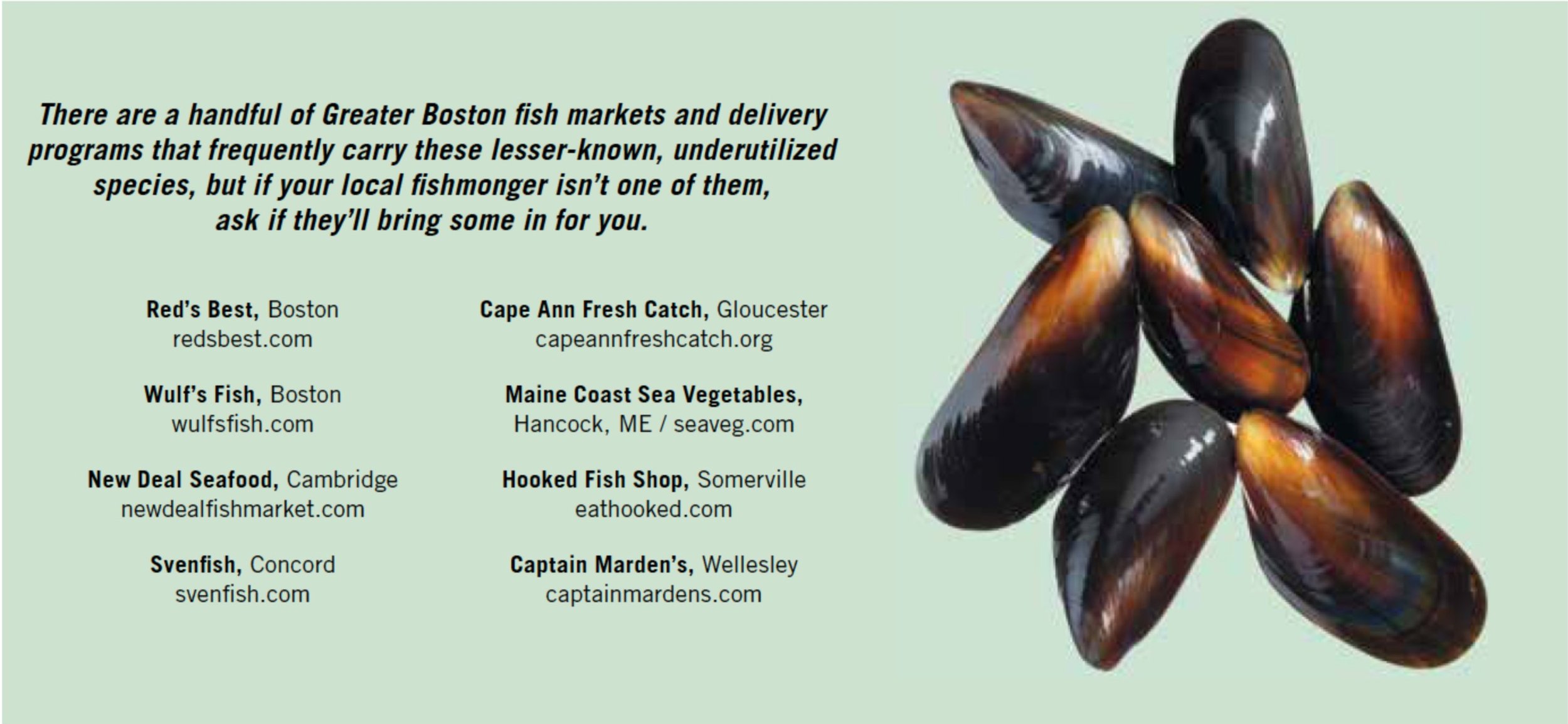Sunken Treasures: A Deep Dive into Underappreciated Seafood
Photos by Michael Piazza / Styled by Catrine Kelty
Here in Boston, we’re known for all sorts of things, especially baseball, baked beans and brainy college students. We also have a reputation for delicious, fresh-off-the boat seafood. Lobster rolls, fried clams and baked haddock are ubiquitous here yet our local waters contain a diverse and abundant ecosystem of lesser-known species that remains virtually untapped.
“Everyone loves cod but there’s not a lot available anymore,” says Boston-area chef and food systems activist Michael Leviton. “Tuna is not a fast-growing fish… and there’s very little of it around here,” he adds, which is why I asked him how consumers and cooks can broaden their horizons and make smart choices in the process. Trying to understand “sustainable” seafood can be confusing. With each purchasing decision we make, are we sustaining a fisherman? A species? Our health, or the health of the ocean? The local economy?
“The conversation needs to be more nuanced,” says Leviton. “And if we’re going to be more nuanced, we need to expand our palates.”
New England’s pristine cold waters provide an array of tasty, affordable and nutritious protein options. These less familiar seafoods are also sustainable because most have stable populations that are not in danger of being overfished. Additionally, by increasing demand for undervalued species, we’re giving local fishermen a boost. It’s a win, win, win.
But how can leery home cooks begin to move beyond their go-to choices, like farmed salmon and Pacific shrimp? How does one begin to test the waters with fish like skate and monkfish that look so strange? “People need to stretch outside their comfort zone,” says Jeremy Sewall, chef and owner of Row 34. Both Leviton and Sewall collaborated with me to provide a sampling of recipes that leverage a few of the many options we are lucky to have here in New England.
Locally caught seafood is a wild product, which means it’s not always predictable. “People need to be flexible and adapt to what’s available,” says Sewall. The best way to set yourself up for success is to try out a variety and see what you like. Think of it as diversifying your portfolio of seafood choices. “Once you learn [how to cook fish], the reward is amazing.” Sewall says.
“Mussels are widely available in this area and happen to be a very affordable and sustainable protein source,” says Leviton, “[and] they’re dead easy and cook super quickly.” In the recipe that follows, the bivalves are cooked in a dry, blazing-hot pan for a few minutes before a healthy glug of saffron-infused wine and butter are added to the mix. With garlic toast to soak up the broth, you’ll wonder why you don’t make mussels for dinner more often.
“We export more local fish than we need to [because] other countries value it more,” says Sewall. “Monkfish is on top of the list.” It may be an ugly creature, but the firm, meaty texture of monkfish holds up beautifully to breading and pan frying. In Sewall’s recipe, the crisp cutlets are accompanied by a lemony mixture of orzo and creamy Swiss chard (which will turn a vibrant pink if you choose rainbow chard!). Why aren’t we keeping more monkfish for ourselves?
Skate, like monkfish, is another bottom-dweller that is most often caught unintentionally as by-catch. “Nobody is really going out fishing for skate, so it’s a bonus,” says Leviton. The filets, or “wings,” have long been prized by French chefs for their delicate flavor and distinct ridges, perfect for trapping buttery sauce. Leviton suggests lightly dredging and pan-frying the wings before spooning over a mixture of roasted cauliflower, browned butter, capers and lemon.
Lastly, a warming winter chowder of cusk and miso utilizes another potential revenue source for fishermen: seaweed. Two types of local kelp—kombu and wakame—provide a delicate, umami-rich broth for earthy red miso and chunks of flaky cusk. The mild, firm cod-like fish is wild-caught from Canada to Cape Cod and is usually available in the winter months.
These recipes are just a gateway to the vast seafood alternatives we have available locally. Sewall suggests we “eat a variety, it’s all delicious.” And, “if you don’t see something you want [at the fishmonger], ask for it.” Your demand will support the local fishing industry, and that’s reason enough to give these unsung heroes a shot.
“It’s part of what makes it so great to live and grow up here,” says Leviton. “To me, that’s super important. To maintain the history of New England.”
This story appeared in the Winter 2023 issue.






